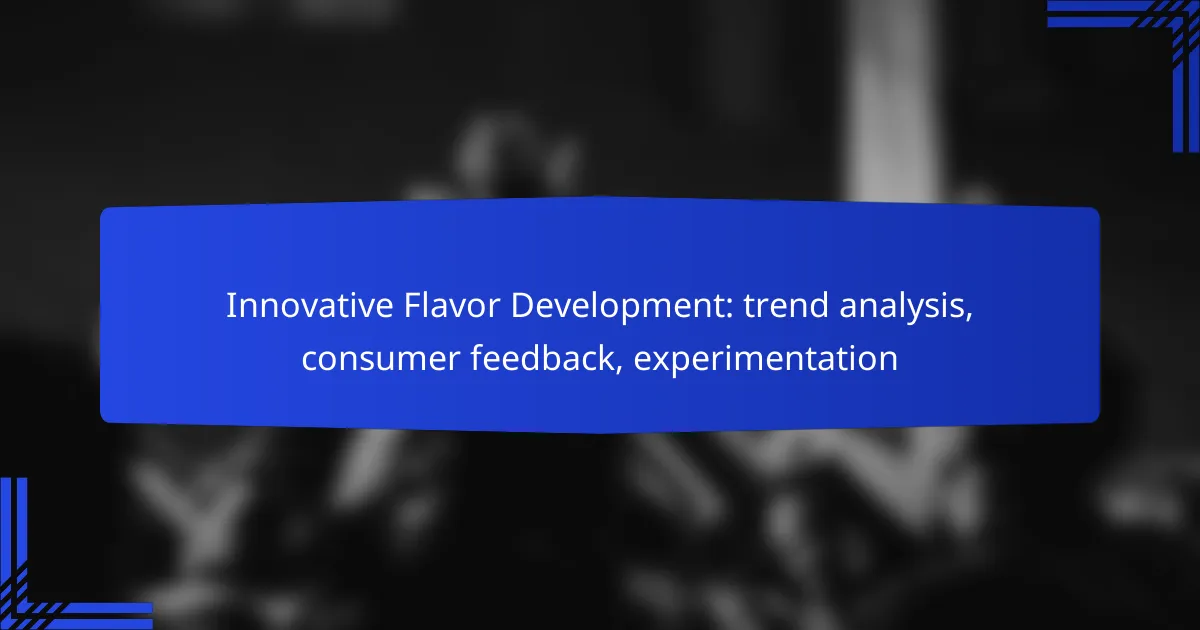Innovative flavor development is rapidly evolving, driven by trends in sustainability, health, and diverse cultural influences. As consumers increasingly seek unique taste experiences that reflect their preferences, brands are compelled to experiment with novel ingredients and combinations. Consumer feedback is essential in this process, offering valuable insights that help refine products to meet market demands and enhance satisfaction.

What are the innovative flavor development trends in Australia?
Innovative flavor development trends in Australia are increasingly focused on sustainability, health, and global influences. Consumers are seeking unique taste experiences that align with their dietary preferences and cultural interests, driving brands to experiment with new ingredients and flavor combinations.
Plant-based flavor innovations
Plant-based flavor innovations are gaining traction as more Australians adopt vegetarian and vegan diets. Brands are experimenting with ingredients like jackfruit, lentils, and various legumes to create flavors that mimic traditional meat products. This trend not only caters to dietary preferences but also supports environmental sustainability.
For instance, companies are developing plant-based sauces and seasonings that enhance the natural flavors of vegetables, making them more appealing to consumers. Utilizing herbs and spices creatively can elevate these products, providing depth and complexity to plant-based meals.
Global cuisine influences
Global cuisine influences are shaping the Australian palate, with flavors from Asia, the Middle East, and Latin America becoming increasingly popular. Consumers are eager to explore diverse culinary traditions, prompting food manufacturers to incorporate exotic spices and cooking techniques into their offerings.
For example, the use of Korean gochujang or Middle Eastern za’atar in everyday dishes is on the rise. Brands can capitalize on this trend by creating fusion products that blend familiar Australian flavors with international elements, appealing to adventurous eaters.
Health-conscious flavor profiles
Health-conscious flavor profiles are a significant trend as Australians become more aware of nutrition and wellness. Consumers are looking for flavors that not only taste good but also provide health benefits, such as reduced sugar, lower sodium, and added nutrients.
In response, companies are reformulating products to include natural sweeteners and functional ingredients like probiotics or superfoods. This approach allows brands to meet consumer demand for healthier options while maintaining appealing flavors, ensuring that taste is not sacrificed for health.

How does consumer feedback shape flavor development?
Consumer feedback plays a crucial role in flavor development by providing insights into preferences and trends. This feedback helps companies refine their products to better meet market demands and enhance customer satisfaction.
Surveys and taste tests
Surveys and taste tests are fundamental tools for gathering consumer opinions on new flavors. These methods allow companies to collect quantitative data on preferences, helping to identify which flavors resonate most with their target audience.
For effective surveys, keep questions clear and concise, focusing on specific attributes like sweetness, spiciness, or overall enjoyment. Taste tests can be conducted in controlled environments or through pop-up events, offering participants a chance to sample and rate flavors directly.
Social media sentiment analysis
Social media sentiment analysis involves monitoring online conversations to gauge public opinion about flavors. By analyzing comments, reviews, and posts, companies can identify emerging trends and consumer sentiments regarding specific flavor profiles.
Utilizing tools that track mentions and sentiment can provide valuable insights. For example, a spike in positive comments about a tropical fruit flavor may indicate a growing consumer interest, prompting companies to explore that direction further. Regularly engaging with consumers on platforms like Instagram or Twitter can also enhance brand loyalty and encourage feedback.

What experimentation methods are used in flavor development?
Experimentation methods in flavor development include various techniques that help identify and refine flavor profiles. These methods allow food developers to explore new combinations and assess consumer preferences effectively.
Flavor pairing experiments
Flavor pairing experiments involve combining ingredients based on their chemical compounds and flavor profiles to discover harmonious blends. For example, pairing chocolate with chili can create a unique taste experience due to the complementary flavor notes. This method often relies on databases that analyze successful pairings across cuisines.
When conducting flavor pairing experiments, consider using a systematic approach. Start with a base flavor and explore potential partners by testing small batches. Document the results to identify which combinations resonate with target consumers.
Use of sensory analysis
Sensory analysis is a critical method in flavor development that evaluates how consumers perceive flavors through their senses. This technique typically involves taste tests, aroma assessments, and texture evaluations to gather feedback on new flavor profiles. Trained panels or consumer groups can provide valuable insights into preferences and acceptability.
To implement sensory analysis effectively, establish clear objectives for the testing process. Use standardized scoring systems to quantify feedback and ensure consistency. Avoid biases by conducting blind tests, allowing participants to evaluate flavors without preconceived notions.

What are the key challenges in flavor innovation?
The key challenges in flavor innovation include navigating regulatory compliance, balancing cost and quality, and responding to consumer preferences. These factors can significantly impact the development and marketability of new flavors.
Regulatory compliance
Regulatory compliance is crucial in flavor innovation, as food and beverage products must meet safety and labeling standards set by authorities such as the FDA in the United States or EFSA in Europe. Companies need to ensure that their flavor ingredients are approved and that they adhere to guidelines regarding usage levels and health claims.
To navigate these regulations effectively, businesses should stay updated on changes in legislation and engage with regulatory experts. This proactive approach can help avoid costly delays or product recalls due to non-compliance.
Balancing cost and quality
Balancing cost and quality is a significant challenge in flavor innovation. While high-quality ingredients can enhance flavor profiles, they often come at a premium price, which can affect overall product profitability. Companies must evaluate their target market and determine the acceptable trade-offs between cost and flavor quality.
One strategy is to conduct market research to identify consumer preferences and willingness to pay for premium flavors. Additionally, exploring alternative sourcing options or innovative production techniques can help maintain quality while managing costs effectively.

How do brands leverage consumer insights for flavor trends?
Brands utilize consumer insights to identify and develop flavor trends by closely monitoring preferences and feedback. This approach helps them create products that resonate with their target audience, ensuring better market acceptance and sales performance.
Collaboration with food scientists
Brands often partner with food scientists to explore innovative flavor combinations and enhance existing products. These experts bring technical knowledge about flavor compounds and sensory analysis, which can lead to unique offerings that meet consumer demands.
For example, a beverage company might work with food scientists to develop a new fruit blend that appeals to health-conscious consumers. By leveraging scientific expertise, brands can create flavors that not only taste good but also align with current health trends.
Utilizing data analytics
Data analytics plays a crucial role in understanding consumer preferences and predicting flavor trends. Brands analyze sales data, social media feedback, and market research to identify which flavors are gaining popularity and which are declining.
For instance, a snack manufacturer might use analytics to track the rise of spicy flavors among younger consumers, prompting them to introduce a new spicy chip line. By continuously monitoring data, brands can adapt their flavor strategies in real-time, ensuring they stay relevant in a competitive market.

What role does technology play in flavor development?
Technology plays a crucial role in flavor development by enabling more precise formulation, rapid prototyping, and data-driven insights. Advanced tools like artificial intelligence and 3D printing allow food developers to create innovative flavors that meet consumer preferences efficiently.
AI in flavor formulation
Artificial intelligence enhances flavor formulation by analyzing vast amounts of consumer data to identify trends and preferences. By employing machine learning algorithms, companies can predict which flavor combinations are likely to succeed in the market.
For instance, AI can suggest ingredient pairings based on historical data, helping developers create unique flavor profiles that resonate with target demographics. This approach reduces the time spent on trial and error, allowing for quicker product launches.
3D printing of flavor profiles
3D printing technology is revolutionizing flavor profiles by allowing the creation of complex taste experiences through additive manufacturing. This method enables the layering of different flavor components, producing intricate taste sensations that traditional methods cannot achieve.
For example, 3D-printed food can incorporate multiple flavors in a single bite, appealing to consumers looking for novel culinary experiences. Additionally, this technology can streamline production processes, reducing waste and improving efficiency in flavor development.

What are the future directions for flavor innovation?
The future of flavor innovation is set to focus on personalized experiences, sustainable sourcing, and the integration of emerging global trends. These directions reflect consumer preferences for unique, environmentally friendly, and culturally diverse flavor profiles.
Personalized flavor experiences
Personalized flavor experiences cater to individual tastes and preferences, allowing consumers to enjoy tailored products. Brands can leverage data analytics and consumer feedback to create flavors that resonate with specific demographics or even individual customers.
For example, companies might use surveys or social media insights to identify popular flavor combinations among target audiences. This approach not only enhances customer satisfaction but also fosters brand loyalty.
Sustainable flavor sourcing
Sustainable flavor sourcing emphasizes environmentally responsible practices in obtaining flavor ingredients. Consumers increasingly demand transparency regarding the origins of their food, prompting brands to adopt sustainable methods that minimize environmental impact.
Examples include sourcing natural flavors from local farms or using organic ingredients. Brands should consider certifications like USDA Organic or Fair Trade to appeal to eco-conscious consumers and differentiate themselves in the market.
Emerging global flavor trends
Emerging global flavor trends highlight the growing interest in international cuisines and unique taste experiences. Flavors from regions such as Southeast Asia, Latin America, and Africa are gaining popularity, influencing product development across various sectors.
To stay ahead, brands should explore these trends by incorporating exotic spices, herbs, and flavor profiles into their offerings. Engaging with cultural narratives and authentic recipes can enhance the appeal of new products and attract adventurous consumers.
